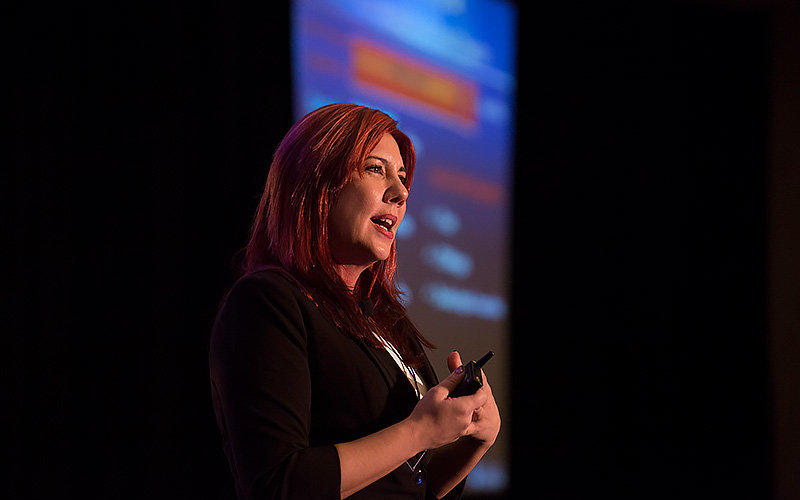
Momentum gained this year in an economic recovery that’s pushing nearly a decade isn’t likely to stop soon, but it will slow in Orange County, according to Cal State Fullerton economists Anil Puri and Mira Farka in their Oct. 25 Economic Outlook and Forecast presentation to nearly 700 business leaders.
Despite anticipation, even euphoria following the Presidential election, not much has changed in terms of the legislative agenda, and the Affordable Care Act remains intact despite repeated attempts in Congress to repeal and replace it, the economic report states. In Orange County, unlike the national economy, weakness seeped into the real economy: the pace of job formation shifted this year and layoffs ramped up — a trend also evident in neighboring Los Angeles County and the Inland Empire and the broader Southern California region.
“So far, all we’ve added is more holes in bigger cheese,” Farka told the crowd. “The epiphany we’ve all been waiting for, the agenda we’ve been hoping for, is tied up in Congress.
“We’ve been waiting for tax and regulatory reform for a long time. So, what’s our outlook? We do believe the outlook is going to be brighter, especially at the national level. We actually think the cheese will get bigger. It’s just that it will be highly dependent on the policy mix, both fiscal and monetary policy. It will depend on the size of the holes.”
Farka and Puri, interim provost and vice president for academic affairs and director of the Woods Center for Economic Analysis and Forecasting, led the two-hour presentation at Hotel Irvine. Farka is co-director of the Woods Center and previously worked on Wall Street as an economist with Deutsche Bank.
Farka sums up the continued recovery this way: “The party will continue even without Washington (D.C.), There’s strong momentum to keep us going forward, solid fundamentals, and not only that, but we do think the recovery is going to spread more evenly.
“The most important risk source is the unknown changes on the fiscal policy and the monetary policy side,” she said. “How they unfold over the next couple of months will truly determine how well the economy will perform.”
Puri said the region’s recovery is paired with “synchronized global growth.” Consumers are optimistic, the gross domestic product has grown since the first quarter, and auto sales picked up in the second quarter.
“The U.S. economy is firing on all cylinders and it is performing better than the economy anywhere else in the world,” he said. “Consumers are feeling better about their housing wealth. Equity in their house makes people feel very good.”
Puri said he’s not surprised that their research determined growth will slow.
“It’s OK we have slow growth. You don’t want a recession,” he said. “There’s nothing wrong with slow growth, as long as it continues.”
From the report:
- For the nation, the labor market expansion will continue over the next two years, though at a more moderate pace than in the previous three years. Job creation is expected to average 165,000 jobs per month this year, 150,000 in 2018 and a more modest 140,000 in 2019.
- Home prices are up, but the rate will slow. The average cost of a home in Orange County is $760,000.
- Construction permits in Southern California will grow by 15 percent in 2017, but are expected to stabilize for the next two years. The Inland Empire is targeted for the most growth.
- Small firms are the most likely to shrink staffs — a trend that began before the Great Recession, but accelerated in the crisis and continues.
The recovery isn’t gender neutral and has been “kinder” to women than men, Farka said. Health care jobs continue to grow, nearly doubling from 12 million in 1997 to more than 20 million now at the national level. But, those jobs are traditionally held by women, which make up about 75 percent of jobs in the health care sector, she said. Meanwhile manufacturing jobs have dropped from 18 million in 1997 to about 12 million today, and those jobs are most often held by men.
About 25 percent of the jobs created since 2010 are in the health care sector. Manufacturing jobs are expected to increase based on the new administration’s agenda, but it’s unlikely to reach the level of the “old glory days,” she added.
Health care isn’t the only growing industry in Orange County. Four sectors: professional and business services, leisure and hospitality, construction and educational and health services have accounted for more than 80 percent of jobs in Orange County since the start of the recovery in 2010, Puri said. But job growth has taken a step back this year and layoffs across the county account for 12.5 percent of reported mass layoffs in California this year — far larger than the share of Orange County employment in California, which is about 9.3 percent, he added.
View the full Economic Outlook and Forecast.